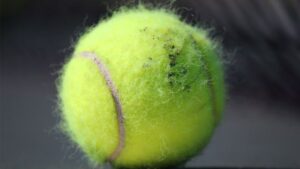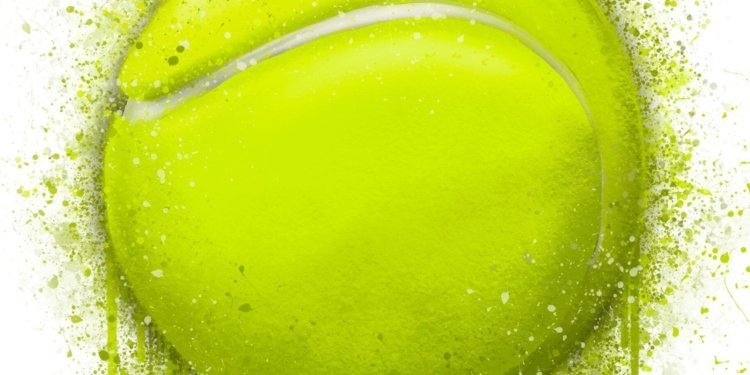Why Is There Fuzz on a Tennis Ball?
The fuzz on a tennis ball serves a purpose in the game of tennis. Tennis balls are covered in a layer of felt, which creates a fuzzy texture. This felt is typically made of nylon or a blend of wool and nylon. The fuzz on a tennis ball helps to control the ball’s flight and bounce. When a tennis ball is struck by a player’s racket, the fuzzy surface creates friction with the air, allowing players to generate spin on the ball. The spin affects the trajectory and movement of the ball, making it easier to control and manipulate during gameplay.
Additionally, the fuzzy felt surface helps the ball to grip the court surface. This allows the ball to bounce in a predictable and consistent manner, ensuring fair play and a level playing field for both players.
Over time, as tennis balls are used, the fuzz on the surface can wear off due to abrasion and friction with the court. This can affect the ball’s performance, as it may have reduced spin and bounce. As a result, tennis balls are often replaced periodically during matches or practice sessions to maintain optimal playing conditions.
The Composition of Tennis Balls
To comprehend the role of fuzz, it’s essential to grasp the composition of a tennis ball. Typically, a tennis ball consists of a rubber core covered by a layer of adhesive and cloth. It is this cloth layer that forms the fuzz, which provides distinct characteristics to the ball during play.
The Purpose of Fuzz on Tennis Balls
The fuzz on tennis balls serves multiple purposes. Firstly, it acts as a protective barrier, preventing the rubber core from wearing out quickly. Secondly, it enhances the aerodynamics of the ball, enabling players to generate topspin, slice, and other shot variations. Additionally, the fuzz contributes to the ball’s grip on different court surfaces, affecting its overall performance.
How Fuzz Affects Tennis Ball Performance
The presence and condition of fuzz significantly influence a tennis ball’s performance. Fuzz allows players to generate spin, altering the trajectory and behavior of the ball. It also impacts the ball’s speed, bounce, and control, making it a crucial factor in strategic gameplay.
Proper maintenance and understanding of fuzz characteristics can be vital in optimizing a player’s performance on the court.

The Science Behind Fuzz Formation
Understanding the science behind fuzz formation on tennis balls involves examining factors such as material properties, manufacturing processes, and frictional forces. The interaction between the ball and the court, as well as the constant impacts during gameplay, contribute to the fuzz development over time.
Factors Affecting Fuzz on Tennis Balls
Several factors influence the fuzz on tennis balls. These factors include court type, ball quality, playing style, environmental conditions, and even the altitude of the playing location. Each of these variables can affect the rate of fuzz formation, its thickness, and its overall impact on the ball’s performance.
Maintaining Fuzz on Tennis Balls
To optimize the performance of tennis balls, players must maintain the right amount of fuzz. Regular cleaning, storage in appropriate conditions, and avoiding excessive wear are key practices to preserve the fuzz. Proper maintenance ensures consistent playability and extends the lifespan of tennis balls.
The Impact of Fuzz on Tennis Gameplay
The presence or absence of fuzz significantly impacts tennis gameplay. Fuzz allows players to impart spin and control the ball’s flight path. It influences the speed, bounce, and skid on different court surfaces, affecting a player’s ability to execute specific shots. Understanding how fuzz affects gameplay can help players adapt their strategies and enhance their performance.
Strategies to Optimize Tennis Ball Fuzz
Players can employ various strategies to optimize the fuzz on tennis balls and tailor it to their playing style. From selecting the right balls for specific court surfaces to implementing maintenance routines, these strategies can fine-tune the fuzz characteristics to suit individual preferences and maximize on-court performance.
The Evolution of Tennis Ball Fuzz
Over the years, the fuzz on tennis balls has undergone changes in design, composition, and manufacturing techniques. Advancements in materials and technology have influenced the development of fuzz, resulting in improved performance and durability. Exploring the evolution of tennis ball fuzz provides valuable insights into the sport’s progression.
The Role of Fuzz in Professional Tennis
In professional tennis, where precision and control are paramount, the role of fuzz becomes even more crucial. Players at the highest level analyze and manipulate fuzz to gain advantages on different court surfaces and against various opponents. Understanding the significance of fuzz in professional tennis can deepen our appreciation for the intricacies of the game.

Common Misconceptions about Tennis Ball Fuzz
Several misconceptions surround tennis ball fuzz. From believing that more fuzz always translates to better performance to assuming that all tennis balls have the same fuzz properties, debunking these misconceptions is essential for players and enthusiasts alike. By dispelling these myths, players can make more informed decisions and improve their game.
Conclusion
The fuzz on a tennis ball is more than just an aesthetic feature; it plays a crucial role in the sport. Understanding why there is fuzz on a tennis ball provides valuable insights into optimizing performance, enhancing gameplay strategies, and appreciating the nuances of professional tennis. By acknowledging the significance of fuzz, players, and enthusiasts can elevate their game and deepen their passion for this beloved sport.
Frequently Asked Questions
Q1: Does the type of court affect the rate of fuzz formation?
A1: Yes, different court surfaces can affect the rate at which fuzz forms on tennis balls. Hard courts, clay courts, and grass courts each have distinct characteristics that influence the wear and tear on the fuzz.
Q2: How often should I replace tennis balls to maintain optimal fuzz?
A2: The frequency of replacing tennis balls depends on various factors, such as playing intensity, court surface, and personal preference. As a general guideline, replacing tennis balls every few matches or when the fuzz becomes significantly worn is advisable.
Q3: Can I enhance the fuzz on a tennis ball?
A3: While it is not possible to enhance the fuzz on a tennis ball after it has been manufactured, maintaining proper care and storage practices can help preserve the existing fuzz for longer.
Q4: Does humidity affect the performance of fuzz on tennis balls?
A4: Yes, humidity can affect the performance of tennis ball fuzz. Higher humidity levels can make the fuzz fluffier and slightly slower, while lower humidity levels can result in a harder and faster ball.
Q5: Are there specific cleaning methods to maintain the fuzz on tennis balls?
A5: Yes, there are several cleaning methods to maintain the fuzz on tennis balls, such as using a damp cloth or specialized tennis ball cleaning solutions. It is important to follow the recommended guidelines to avoid damaging the ball’s fuzz or compromising its performance.

Hi there! My name is Hamza Rahim and I’m a seasoned tennis player with a passion for helping players of all levels to improve their game. With great experience. I have developed a deep understanding of the sport’s techniques and strategies. I will help tennis lovers to select the best tennis racquets, and balls and also share tips to become the best player on the ground. I hope from my information you will become a great tennis player as well as in your country and also worldwide. And my goal is to provide you with the best information about tennis.











